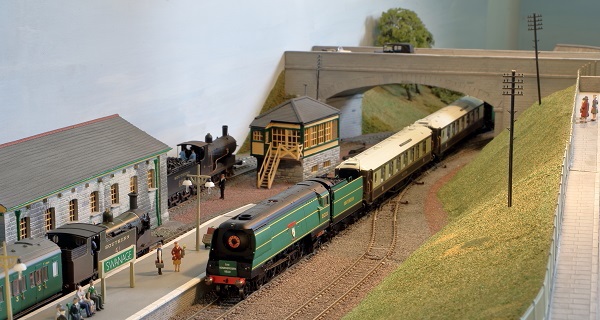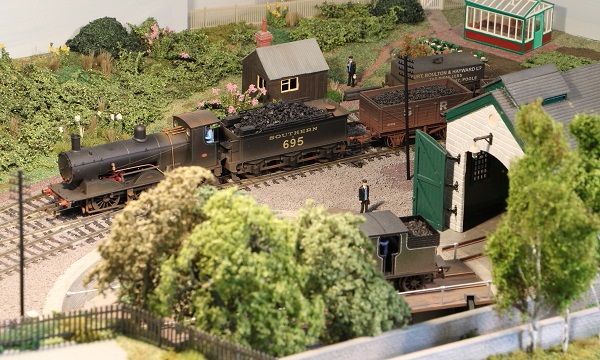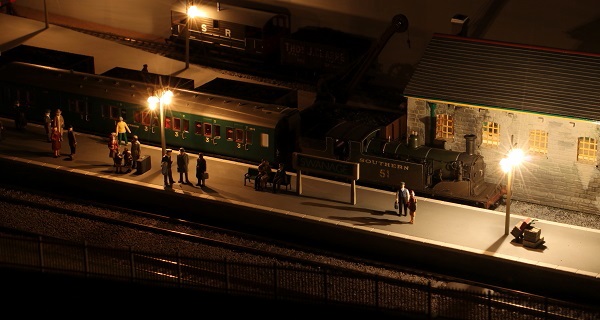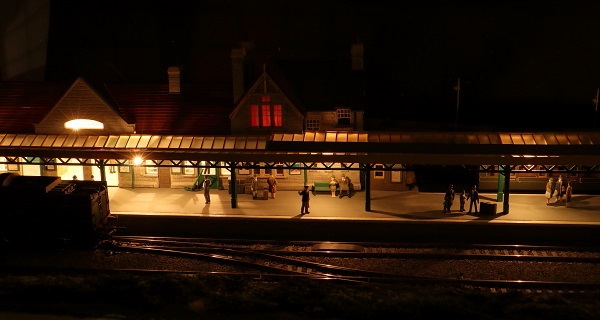Please be aware of our copyright notice. If you have a good reaon for using a photo from this site ask permission from first - it is frequently given.
Swanage
by Michael Howarth
|
A busy station, viewed from the main bridge. A weathered N Class emerges from the goods shed. Motivation The original inspiration for modelling Swanage, on the south coast of England, was the childhood holidays I enjoyed shortly before the 1972 closure of the line, then diesel-operated. My model however looks back to a busier era of steam. The branch line was served by an interesting range of passenger trains, and the station's track configuration enabled a wide variety of locomotive and stock movements. These factors combine to make operating the model a joy.
The model is set on a summer Saturday in 1947, the last of the Southern Railway era before nationalisation. There is a busy passenger service, bringing holidaymakers to the seaside on long-distance trains: direct services from Waterloo; through coaches coupled to local services at Wareham; and services from the north of England via the SDJR. There are also medium distance and local passenger services (Swanage - Corfe - Wareham). A modest freight service is supported. The post-war date allows Bulleid West Country and Battle of Britain lightweight pacifics, in service from 1945. The earliest date for which I have evidence of Bulleid pacifics at Swanage is 1954, although Merchant Navy pacifics passed the end of the branch line (at Wareham) on Waterloo - Weymouth services in June 1949, and the lightweights were working the SDJR by 1951. Cutting through all these "might have beens", my model has lightweight pacifics hauling direct services between Waterloo and Swanage, and over the SDJR. The choice of 1947 also allows a variety of liveries. In evidence are Maunsell's sage green (used until 1938), Bulleid's malachite green & sunshine yellow (1938 onwards, but little implemented during wartime), and wartime black (generally applied to freight and local passenger locomotives). Together with LMS lake / maroon livery stock used for north of England services (e.g. from Manchester) and the occasional G*R coach (I imagine from south Wales via Bristol / Bath and the SDJR), a colourful and fascinating range of locomotives and coaches would have been seen at the station, especially in the summer months.
The model is OO (1:76) gauge, with the station and approach built on a pair of 1200mm x 600mm baseboards, so 2.4m length, with track laid on cork on Sundeala board. At the station throat a 450mm radius turn runs into a fiddle yard (on a pair of 1000mm x 450mm baseboards), the tightness of this curve forced on me by limited space. The model's length constraint limits trains on the main platform to three coaches, or four with point fouling. The baseboard width of 600mm means that there is space for only one coach siding, instead of the four that existed on the prototype. The main station building, canopy, platform, goods shed, bungalow and bridge are all scratch-built using plasticard. The signal box, turntable, water tower and engine shed are based on kits, all bashed to various degrees. People are important on a busy passenger station such as Swanage, so there are plenty hanging around on the platform and at the station entrance, where they are arriving and departing by bus, taxi and by foot. The roofs of the ticket hall, goods shed and signal box are all removable to reveal modelled interiors with busy staff, and yet more passengers in the booking hall. The track is Peco Streamline 100, mostly Electrofrog points except where space constraints on crossovers forces me to use Setrack Insulfrog. Point motors are always an interesting choice on a model: I opted for Fulgurex slow acting motors (realistic movement but noisy) on the main model, and a mix of Peco above- and below- baseboard motors in the fiddle yard. One component missing from the model is the signals - I'll be getting round to building those, erm..., "soon"! The model is conventional 12V DC analogue electrical - who knows, I may also get round to implementing DCC one day!. |
|
· Station overview with West Country Class N°21C110 Sidmouth and a pair of coaches in the main platform, and in the bay platform an M7-hauled local service to Wareham.
T9 class N°hauling an up service under the bridge and past the water tower and turntable .
The Bournemouth Belle was re-introduced by the Southern Railway after the war in October 1947, but I have improved on reality by restarting the service in time for the summer 1947 season. In a further improvement, on summer Saturdays a Swanage portion is taken on from Bournemouth into Swanage. Here, a pair of Pullman coaches with luggage van are brought into the station by West Country Class N°21C120 Seaton.
· Q Class N°695 takes a coal train past the engine shed and turntable. An M7, mostly hidden by trees, simmers on the turntable.
Night-time scene at the station, an M7 service in the bay platform. At present I do not have a push-pull coach, so in the interim a conventional Maunsell coach provides the Wareham service. It is important to me that a model railway be capable of operating at night-time, so the platform lights and coach siding lights all work, and all buildings have internal lights. The light cast through the windows of the buildings on to the track and on to the rest of the model makes for a magical atmospheric effect.
Night scene number two - the main platform.
The Station Master's House and Ticket Hall, seen off-baseboard, from the road side. Because of the length constraints, typical with so many model railways, I have constructed the building at about two thirds of the length of the prototype. I think this still captures the elegance and beauty of the original. :-)
Behind the scenes: the (empty) fiddle yard. Click for a larger view. |
Webmaster note: to see how faithfully Michael has modelled the buildings take a look at our page on Swanage station.
This page was created 17 October 2022








